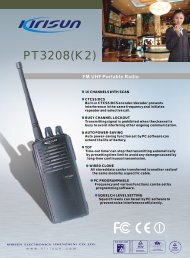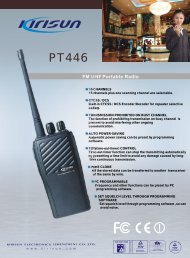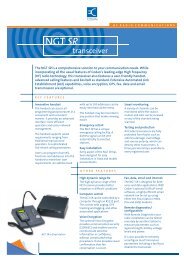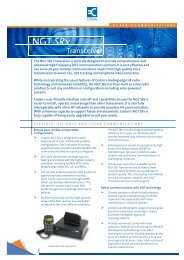R2600 Series Communications System Analyzers Service ...
R2600 Series Communications System Analyzers Service ...
R2600 Series Communications System Analyzers Service ...
You also want an ePaper? Increase the reach of your titles
YUMPU automatically turns print PDFs into web optimized ePapers that Google loves.
Standard <strong>System</strong> Features – continued<br />
Feature Description Benefits<br />
Signaling Simulator:<br />
Encoder and Decoder<br />
General Purpose<br />
& Modulation Oscilloscope<br />
AM, FM Signal Generator<br />
Off-the-Air Sensitive Receiver<br />
Electronic Software Updates<br />
Cable Fault (standard in R2670;<br />
optional in <strong>R2600</strong> and R2625)<br />
RS-232/Serial Interface (standard)<br />
IEEE-488-2 Interface (optional)<br />
6<br />
The <strong>System</strong> Analyzer includes the capability of<br />
encoding and decoding PRIVATE LINE (PL),<br />
DIGITAL PRIVATE LINE (DPL), and single tone<br />
sequences as well as multi-tone sequences<br />
including DTMF signals, 5/6 tone paging,<br />
Select V and up to 20 sequential tones.<br />
Decoding displays include tone frequencies<br />
and time durations of the individual tones. The<br />
unit can also encode tone remote signaling.<br />
The oscilloscope has a 50 kHz bandwidth for<br />
audio waveform analysis. The display can be<br />
triggered over the full screen range to a fixed<br />
reference level. Triggering in both automatic<br />
and normal modes is provided for synchronizing<br />
the horizontal timebase to the vertical<br />
input signal. Internal or external inputs allow<br />
observation of both generated and monitored<br />
modulation signals. Softkeys provide for an<br />
enlarged full screen display.<br />
The optional High Performance Spectrum<br />
Analyzer (standard on R2670) adds Marker<br />
functions for more precise measurements of<br />
Voltage, Frequency, and Period.<br />
When the GENERATE mode is selected, the<br />
RF modulation method, carrier frequency,<br />
bandwidth, composite audio modulation,<br />
and RF signal level output are displayed on<br />
the LCD.<br />
The 2 microvolt sensitivity of the unit is<br />
available through the antenna port. This allows<br />
off-the-air monitoring of remote transmitters<br />
operating up to 1 GHz. Variable squelch aids<br />
in picking up weak signals but can be set<br />
tighter to ensure the proper S/N ratio for<br />
measurement accuracy.<br />
High-Speed serial port and flashable memory<br />
permit programming firmware updates from an<br />
external PC.<br />
Cable fault and length are RF measurement<br />
features which help the technician isolate<br />
cable defects. Supported by on-screen<br />
prompts and user-selectable Help messages,<br />
you can quickly set up and accurately<br />
determine the distance to a fault on a coaxial<br />
cable. The distance to fault (or cable length)<br />
is computed and displayed in feet or<br />
metric units.<br />
A full bi-directional RS232 port is standard<br />
and includes the capability to respond to serial<br />
input command vocabulary and return measurement<br />
results as a serial output stream.<br />
Included are user-selectable baud rates (up<br />
to 115.2 Kbps) and start, stop and parity bit<br />
selection. In addition, this dual function port<br />
can drive a serial printer to print out data and<br />
graphic displays. The optional IEEE remote<br />
interface option contains the necessary<br />
hardware and software for IEEE-488.2.<br />
The signaling capability of the unit reaches<br />
a broader range of service applications with<br />
its decode capability. This gives you a more<br />
flexible test instrument which aids in servicing<br />
paging equipment and specialized signaling<br />
encoders, as well as mobile, portable and<br />
other radio products. The signaling simulator<br />
can perform a full system check-out faster,<br />
with more accuracy than ever before.<br />
Recovered audio or internally produced<br />
audio can be displayed visually for deviation<br />
measurements. Additionally, detection of an<br />
asymmetric modulation or audio distortion can<br />
be achieved with waveform analysis. With<br />
internal and external triggering and a freeze<br />
display single sweep, this unit duplicates many<br />
features of more expensive scopes. The<br />
markers allow detailed analysis to measure<br />
waveforms displayed on the LCD. The EXPAND<br />
function provides an enlarged, easy to<br />
interpret view of the signal for quick analysis.<br />
In addition to reducing receiver test time, this<br />
flexible, self-calibrating signal generator is<br />
complemented by the simultaneous display of<br />
all necessary control information.<br />
This feature reduces service costs by enabling<br />
frequent preventive maintenance parameter<br />
checks for system degradation or interference<br />
identification without leaving the shop.<br />
Quick and easy access to future software<br />
updates.<br />
Cable fault locating techniques are mandatory<br />
for site servicing, where visual inspection<br />
is not practical, safe, or effective in detecting<br />
hidden or cold-flow damage. The semi-automatic<br />
operation of the cable faultfinder<br />
precludes the use of mathematical formulas<br />
and manual calculations, maximizing your<br />
on-site productivity.<br />
If you have large volume repetitive testing<br />
requirements, this feature allows you to write<br />
your own programs to reduce test time costs.<br />
Printed results can be used as part of the<br />
service shop’s internal quality control system<br />
and can be used to demonstrate performance<br />
to the radio equipment user.











